|
|
|
Adverts above are not related to this site
Preliminary Analysis of Forest in Sibulan Watershed reserve
and surrounding forest patches.
Chloé Galley
Dept Zoology, Oxford University, Oxford OX1 3PS email: chloe.galley@wadham.ox.ac.uk
Introduction
The Plotless Centre Quarter Method (PCQM) was used to provide a quantitative description of habitats at sites where frog surveying was carried out, and Varanus olivaceus lizards were caught. This method is aimed at characterising the habitat by estimating density, basal area and relative species abundance of trees.
The identity of many trees was known therefore it was decided that some approximate information could be obtained for the sites (and general area) with regards to their relative level of disturbance, by estimating seral stage and endemicity for these trees. It must be noted that this latter analysis was hindered by the fact that the number of scientific species names which we obtained was a low proportion of the total number of tree types which were measured. However, with this further knowledge of each known tree species (with regards to the habitat and level of endemism), scores were assigned to each site:
Aims
Methodology
Obtaining Data
The Plotless Center Quarter Method (PCQM) for each site, involved a transect of at least 80m long, with points at 5m intervals. The transect ran perpendicular to the river at each site and continued for at least 40m up each bank, or to the crest of the hill (whichever was the greatest). At each 5m interval the four nearest trees to the central point were recorded (the nearest one in each of four quarters of an imaginary cartesian grid), circumference at breast height (CBH) for trees of CBH > 31cm, in order to eliminate new growth trees. The CBH, distance from the central point, quarter of the cartesian grid (NW, NE, SE or SW) and local name were recorded for each tree. A voucher specimen was taken and sent (with the local name) to the Department of Plant Sciences at the University of the Philippines (Los Banos) to be identified.
From these measurements decorana plots were produced to group sites in terms of similarity.
Analysis of the tree species
Information was gathered for each species from a variety of sources (Kubitzi K. et. al. 1993; Mabberley D. J. 1995; Merrill E. D. 1923-1926; Soepadmo E. & Wong K. M. 1995; Steenis C. G. G. J. van 1958-1989).
The score for endemism was given to each named species by assigning points, according to the extent of its approximate range. From this, each site could then be scored by summing these points and dividing by the number of trees (for which the species name was known). A score of 200 was assigned to species found only in the Philippines; 100 to those found within a restricted range (usually including certain islands of the Indonesia or Papua New Guinea; and 0 to those found throughout Malaya). This enables an estimate to be made, so that a site of 100 points say, can be said to have 50% complete endemism (and 50% species of 0 value), or 100% ‘restricted range species’ (and 0 % species of 0 value) or a combination of any of these.
The pioneer index was similarly calculated by allocating known each species to a category according to the approximate seral stage which it inhabits, and scoring ‘Pioneer Index’ points (and so sites) according to this.
Correlations were drawn from these results.
Results
Ordinations using decorana were carried out for the various sites for each of the tree species which were named. Sites seemed to fall into spatial categories as shown. Ordinations shown are for particular species which seem to illustrate well (and probably account for much of the distribution which results. The ordinations are as follows:
Dipterocarpus speciosus Figure1.
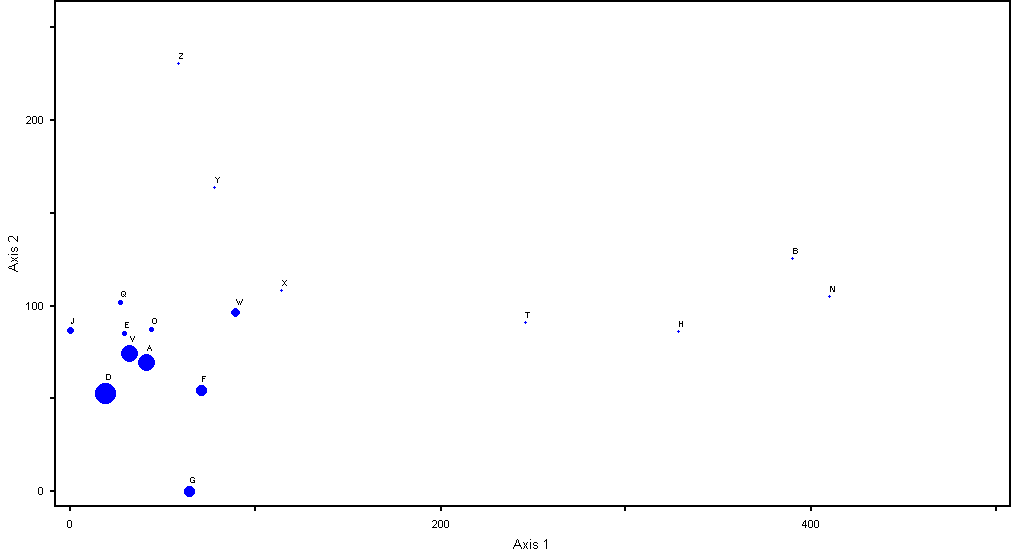
Hopea malibato Figure 2.
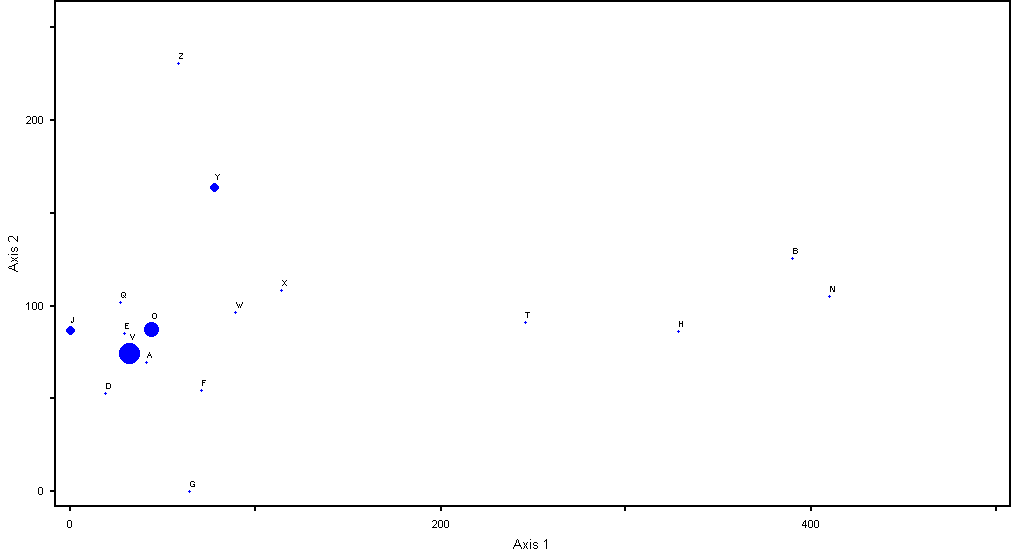
Litchi philippinensis Figure 3.
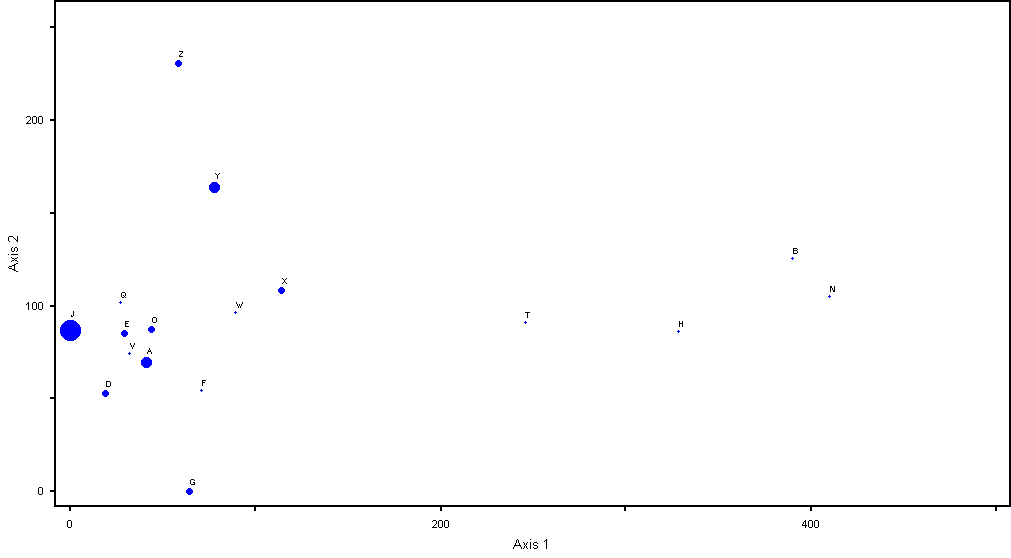
Shorea palosapis Figure 4.
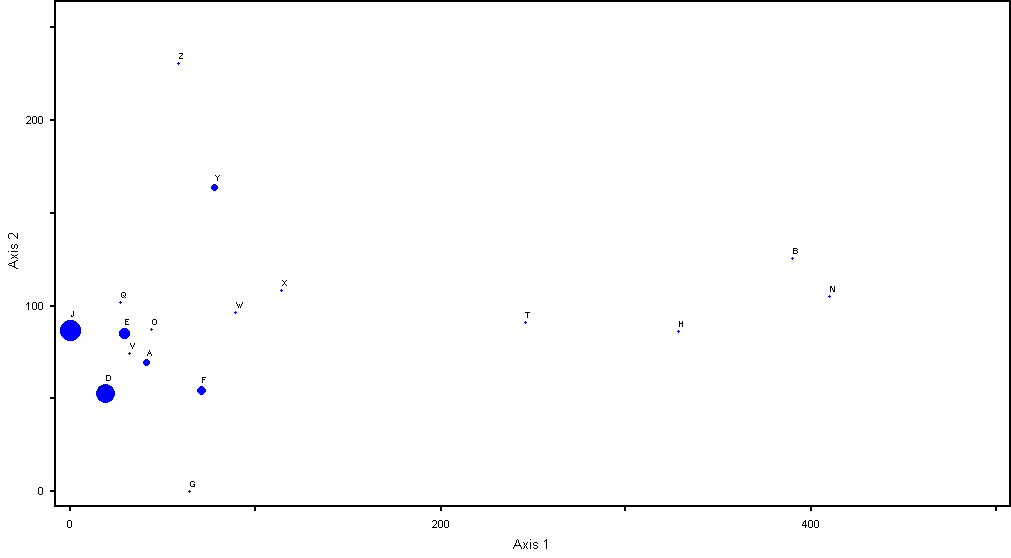
Shorea negrosensis Figure 5.
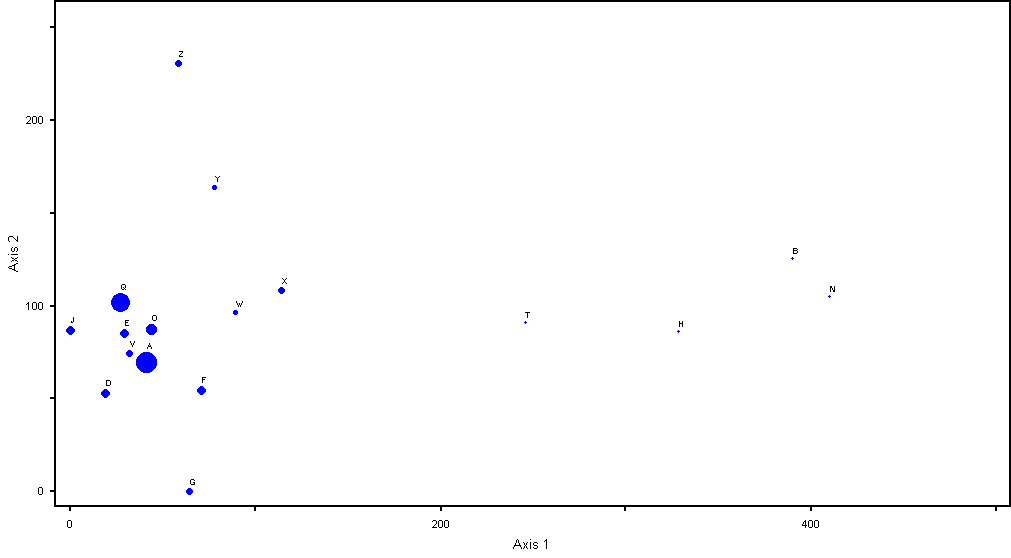
Mangifera altissima Figure 6.
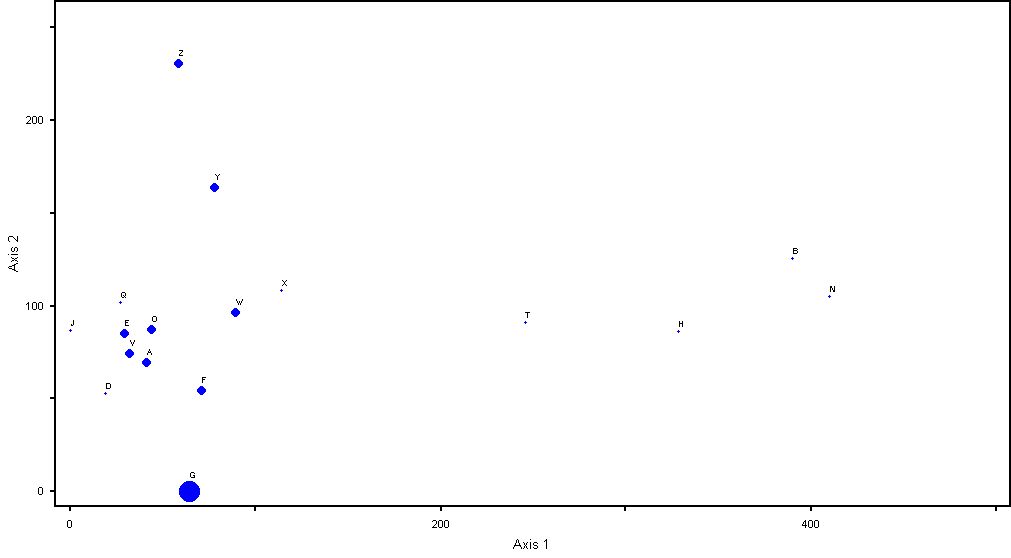
Syzygium nitidum Figure 7.
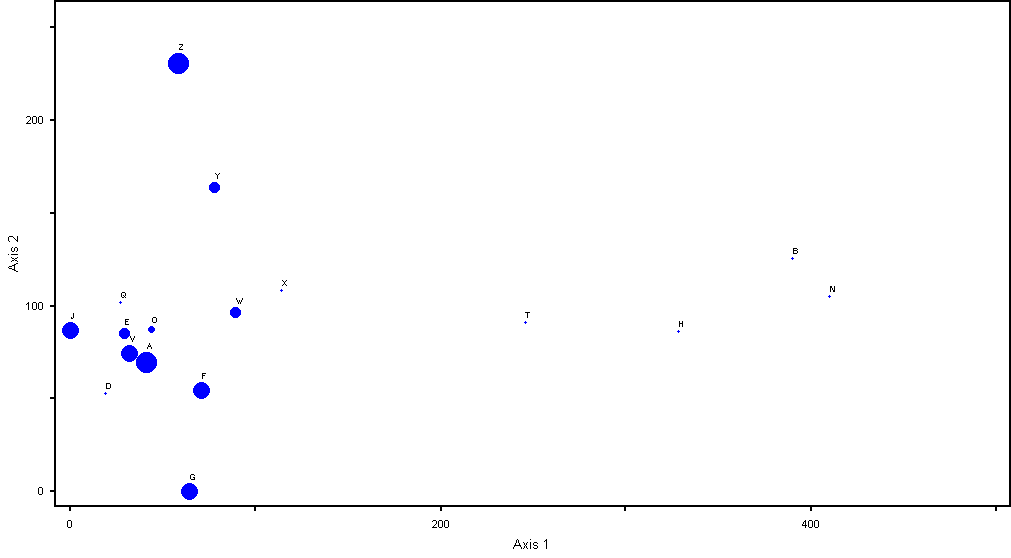
Cananga odorata Figure 8.
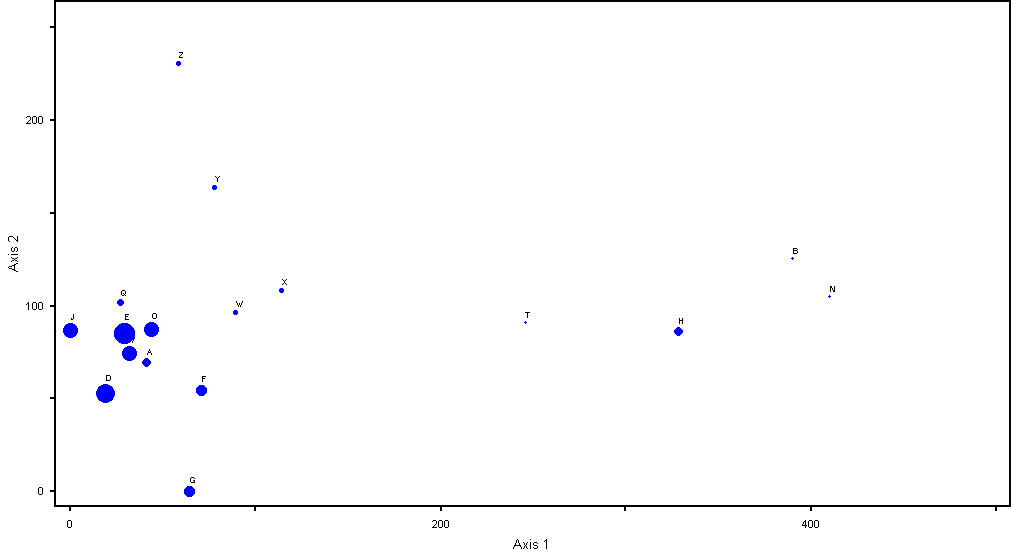
Nara Figure 9.
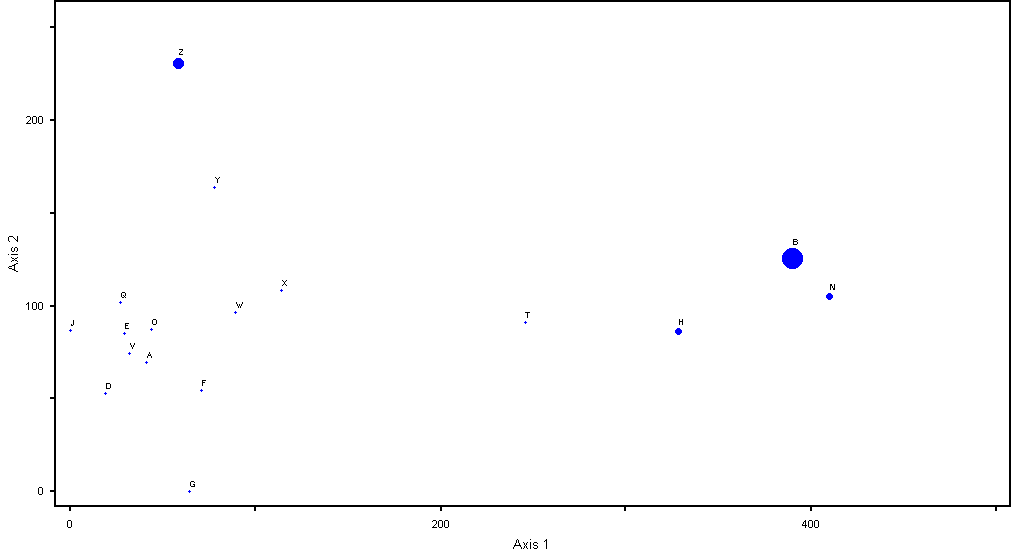
Ficus nota Figure 10.
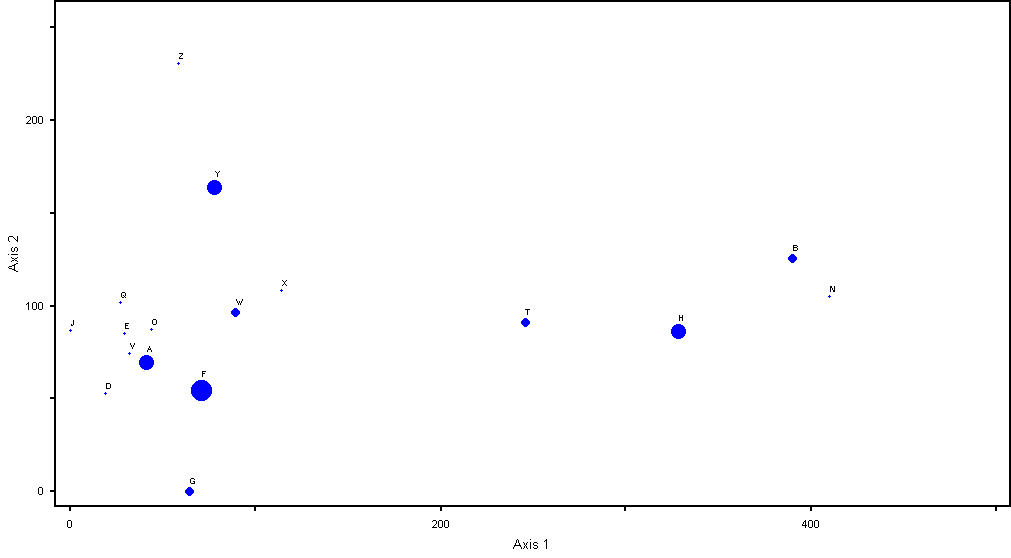
Gnetum Latifolium Figure 11
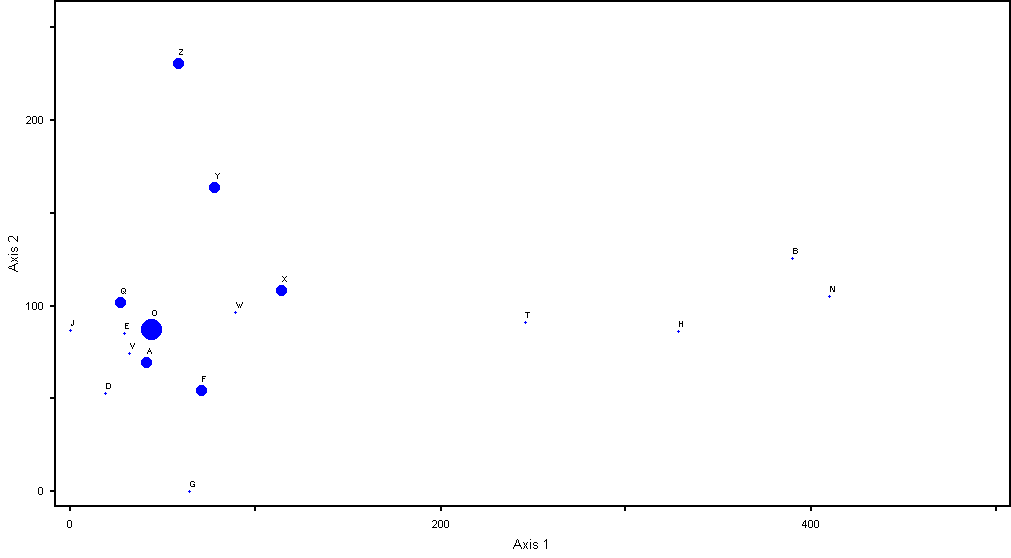
Syzygium polycephaloides Figure 12.
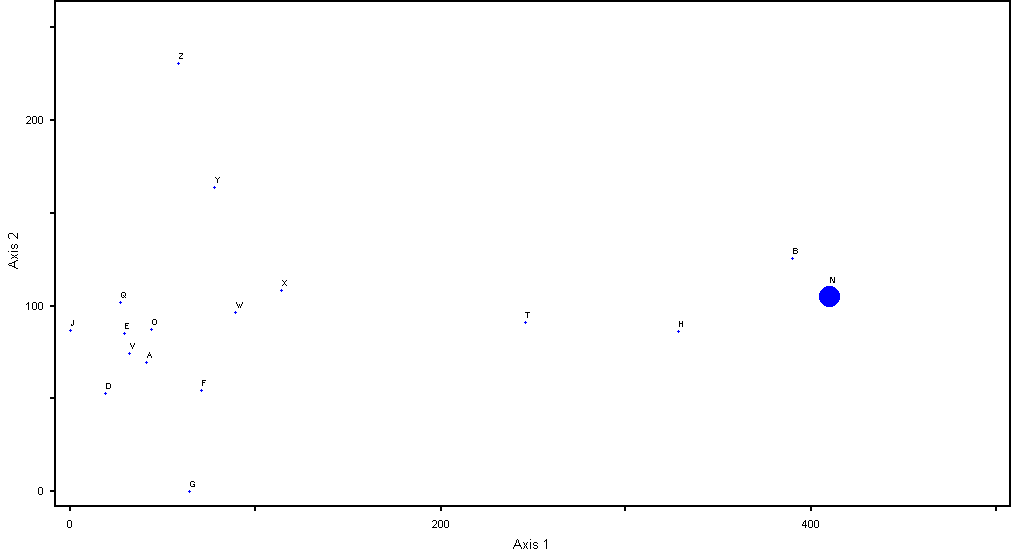
Cocos nucifera Figure 13.
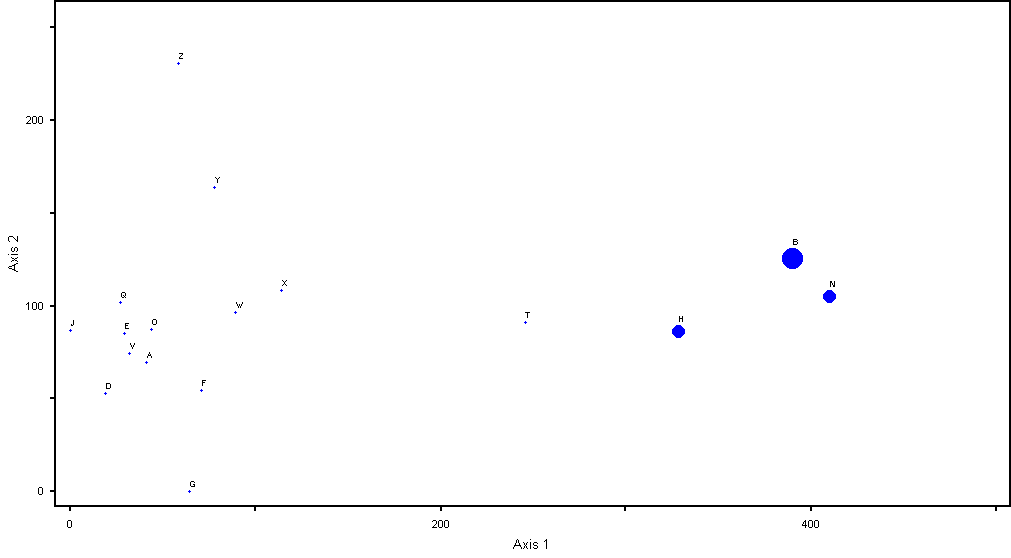
Graph showing the relationship between the Pioneer Index and the Axis 1 obtained form the ordinations. Figure 14.
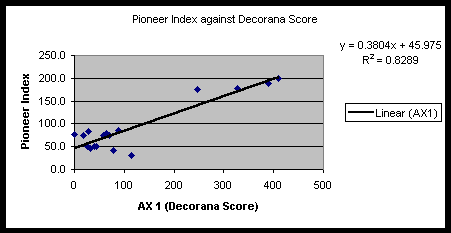
Graph illustrating the endemism value for each site. Figure 15
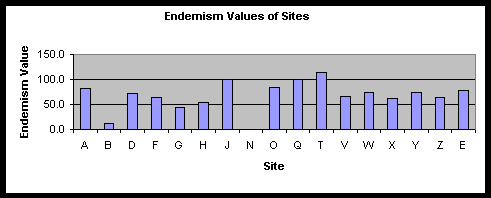
Graph showing the plot of the endemism value against the pioneer index. Figure 16.
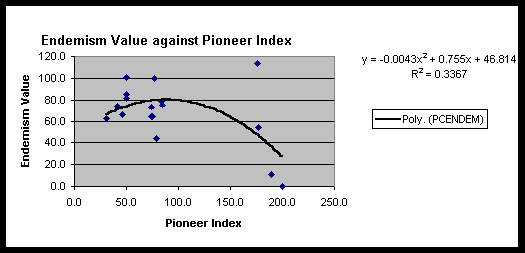
Discussion
The close correlation (R²=0.8289) between the ‘Pioneer Index’ and the ‘Axis 1’ from the decorana plot indicates that in an ordination involving Axis 1 (such as in figs. 1 to 13) that this axis is a relatively good illustration of grouping the sites according to the relative level of disturbance. Thus clusters of sites which form on this ordination are ‘natural’ groups in terms of disturbance, due to abundance of certain species found in them. One such cluster (or rather a continuum in this case) is that including sites B, N, H and T, which are likely to be heavily disturbed. The presence of coconut (Cocos nucifera) and other cultivated species which appear in sites B, N and H (figs. 13 and 12) supports this hypothesis. Sites H and T seem to fit less well into this cluster. The reason for the position of site T cannot easily be explained, whilst site H has a probable explanation. The river which runs through this site (which thus is the centre of the transects for the PCQM, literally divided the land into cultivation (coconuts) on one side, and forest edge on the other (albeit probably composed of pioneer forest species). This is the reason for the intermediate position of site H and this would perhaps become more clear if the data set for this site was treated as two separate sets.
The graph showing the endemism value of each site enables the results of this to illustrate the conservation value of certain areas of the forests. Out of 17 sites, 13 sites (A, D, F, H, J, O, Q, T, V, W, X, W, Y, Z and E) lie above the endemism value of ‘50’ meaning that these all had (out of the species which were identified) either 25% or more of the species endemic to the Philippines; 50% or more as ‘restricted range species’ or a combination of this. There are 3 sites which have a value of 100 or more (J, Q and T). Several of the sites of value 50 or more lie outside of the watershed reserve (A, F, H (although on the edge), O, Q, T, V, W, X, Y and Z). These sites were are mostly sites located within small forest patches, which illustrates the importance these small patches may have in terms of species composition with respect to trees. From this, it also suggests that perhaps these sites ought to also have some degree of protection upon them, although further research would need to be carried out in order to find out the use which these patches have with the locals, and the extent of (natural or ‘man-made’) management / disturbance which they already endure. From the decorana plots, it would appear that they contain species which are typical of fairly undisturbed forest, such as Mangifera altissima (fig. 6 ), Syzygium nitidum (fig. 7), Litsea philippinensis (fig. 3) or Shorea ‘blanco’ –species also commonly found within ‘older’ forest within the watershed reserve.
It should not be deduced from this that the watershed reserve holds little value in terms of endemism of the trees. This skewering of the number of sites outside the watershed with high endemism scores (compared to inside it) is an artifact caused by the higher number of sample sites which were taken from outside the reserve.
The correlation between the endemism value and the pioneer index is low (R²=0.3367) therefore indicates it is not simply a matter of protecting and conserving only the low disturbance habitats, as these are not necessarily those with the highest number of endemic species. As expected the sites that had many cultivated species tended to have very low values of endemicity (for example sites B and N).
Certain species clearly illustrate the important role of a protected area such as the watershed reserve. For example there are several species that are endemic to the Philippines and also are characteristic of undisturbed forest. Examples of those which were also found mainly within the watershed reserve include many Shorea species, Albizzia acle, Calophylum ferugineum and Hopea malibato. Figures 5, 4 and 2 illustrate this –showing that the sites which contain Hopea malibato, Shorea palosapis and Shorea negrosensis, for example, are often situated within, or very close to the reserve (such as sites J, E, D, F and to a certain extent A). Thus the reserve provides protection to (relatively large) areas of quite undisturbed forest, this illustrates its role in conservation of these endemic species which without the protection would be unlikely to survive.
There are certain species which do not have such a straight-forward distribution. Figure 9 shows the Nara tree (Latin name not obtained). It inhabits mostly cultivated sites (H, B and N) but also site Z, which by considering other tree species seems to be a less disturbed area. Further knowledge about site Z would be needed to resolve this. The Nara tree may have been planted in the forest at Z as a useful agroforestry tree and is able to survive in this type of forest. Alternatively it may be a naturally occurring tree in the sites where it is found, and the examples which remain in the cultivated sites are relic trees, kept for their useful purposes.
Ficus nota (figure 10) shows a similar pattern in that it was found at forest sites (to an even greater extent than the Nara) and also at coconut plantation, site B. Four of the forest sites at which it was found were edge sites, and so again its appearance may either be due to plantation in these edge sites, or as a relic tree in cultivated areas; alternatively it may be primarily a cultivated tree which has ‘escaped’ into the edge of forest sites, where it has survived, being a pioneer tree.
Site T had the highest recorded level of endemism, yet its ordination position suggets it is disturbed. This could be due to the close proximity of agricultural habitats.
Conclusion
This analysis was limited by the fact that we did not have the complete set of species names of all of the trees that were measured. It is unlikely that there is a bias with respect to the types of trees for which we were able to get scientific names for, compared to those for which we were not (non-identification was largely due to lack of voucher specimen rather than due to non-identification by the Department of Plant Sciences at UPLB). It also enables the relative levels of disturbance to be shown and patterns seen which may not have been so clearly illustrated from the quantitative data alone.
Some forest outside the watershed reserve contains important tree species in terms of endemicity, and some patches appear to be relatively less disturbed –which may be of importance with respect to the fauna which, although was not surveyed here (except for V. olivaceus) may well exist. For this reason there is a need for more surveying of fauna in these forest patches and a more extensive (increasing the sampling size, to cover more of the forest) and intensive survey of the flora of the watershed reserve and its surrounding forests.
Appendix
The following names are local names of trees that represent those which were included in the PCQM measurements, but for which we did not obtain the scientific names:
Acli, Anahow, Ba gin, Bahaye, Ballyabas, Balobo, Bamcaro, Banga, Biagambing, Biasacan, Bilanga, Bilocaw, Bitokolin, Boc boc, Bong liw, Bota bota, Camagaay, Camantigi, Colilishaw, Dampol, Danlig, Dingn butaki, Dogoan, Dolotan, Eyeoupad, halupag, Ibanoo / Ibano, Ilang ilang gobat, Lampang, Layasin, Ligas, Lobayo, Madrecacao / Madricacau, Mala byabas, Malabowang (amamaho), Malabuyat, Malacacao, Malacalamias, Malaitmubant, Malatobig, Mercing, Milipili, Mowlowing, Nara, Pako pako, Parabaena, Parisparis, Santol, Santol gobat, Solanum, Talisay, Tamaouyan, Tangili, Yakal blanco, Yimilina.
Although we were unable to identify these trees, this list gives an impression of the extent of variety and diversity of tree types (and probably species) we encountered in (what would be for this purpose) only a small sample of the whole forest.
The following table lists the trees for which scientific names were obtained and therefore subsequently used for analysis according to endemicity and 'pioneer index' (to estimate the seral stage).
|
Common Names |
Latin Name |
Family |
|
|
Acli, Akli, Acle |
Albizzia acle |
FABACEAE |
|
|
Batino |
Alstonia macrophylla |
APOCYNACEAE |
|
|
Bunga, Bonga |
Areca catechu |
PALMAE |
|
|
Nangca |
Artocarpus heterophyllus |
MORACEAE |
|
|
Antipolo |
Artocarpus sericicarpus |
MORACEAE |
|
|
Putat, Potat gobat |
Barringtonia gitengensis |
BARRINGTONIACEAE |
|
|
Anagee |
Canarium asperum |
BURSERACEAE |
|
|
Pilaway |
Canarium hirsutum |
BURSERACEAE |
|
|
Ilang ilang, Elang elang |
Caranga odonata |
ANNONACEAE |
|
|
Pugahan |
Caryota rhumphiana |
PALMAE |
|
|
Tapat tapat |
Casearia fuliginosa |
FLACOURTIACEAE |
|
|
Marisparis |
Champereia manillana |
APILIACEAE |
|
|
Toug |
Claoxylon sp. |
EUPHORBIACEAE |
|
|
Marang |
Cleistanthus sp. |
EUPHORBIACEAE |
|
|
Coconut |
Cocus nucifera |
PALMAE |
|
|
Catman, Catmon |
Dillenia philippinensis |
DELLINIACEAE |
|
|
Soupsong aita, Sosongaita |
Diospyros ahernii |
EBERACEAE |
|
|
Apitong |
Dipterocarpus speciosus |
DIPTEROCARPACEAE |
|
|
Malasantol |
Dysoxylum arborescens |
MELIACEAE |
|
|
Tagawi |
Dysoxylum venosum |
MELIACEAE |
|
|
Bilawang, Bilwang |
Endospermum peltatum |
EUPHORBIACEAE |
|
|
Malaruhat, Malarohat |
Eugenia elliptifolia |
MYRTACEAE |
|
|
Capi capi |
Fagraea racemosa |
LOGANICEAE |
|
|
Tibig |
Ficus nota |
MORACEAE |
|
|
Palomaria, Tangisang biawak, |
Ficus variegata |
MORACEAE |
|
|
Boutong manok, Boutong manoc |
Gnetum latifolium |
GNETACEAE |
|
|
Balotangginto |
Gonocaryum calleryanum |
ICACIACEAE |
|
|
Daling dingan |
Hopea malibato |
DIPTEROCARPACEAE |
|
|
Ipil ipil |
Intsia sp. |
FABACEAE |
|
|
Laniti |
Kibatalia gitengenis |
APOCYNACEAE |
|
|
Haloopag, Halopag |
Litchi philippinensis |
SAPINDACEAE |
|
|
Marang bitokoleen |
Litsea ampla |
LAURACEAE |
|
|
Anangay, Pilig (on Luzon) |
Livistonia grandifloris |
BURSERACEAE |
|
|
Takipasin, Tacipasin |
Macaranga bicolor |
EUPHORBIACEAE |
|
|
Manga manga, Pahotan |
Mangifera altissima |
ANACARDACEAE |
|
|
Camoling, Kamoling |
Microcus stylocarpa |
TILIACEAE |
|
|
Bansalagin |
Mimusops sp. |
SAPOTACEAE |
|
|
Lanotan |
Mitrephora reflexa |
ANNONACEAE |
|
|
Banana |
Musa sp. |
MUSACEAE |
|
|
Bankal, Bancal |
Nauclea elmesis |
RUBIACEAE |
|
|
Bulala |
Nephelium rambutan |
SAPINDACEAE |
|
|
Anibong |
Oncosperma horridum |
PALMAE |
|
|
Palosapis |
Palaquium sp. |
SAPOTACEAE |
|
|
Bagtikan, Danlig |
Parashorea malaanonan |
DIPTEROCARPACEAE |
|
|
Abucado, Abocado |
Persea americana |
LAURACEAE |
|
|
Tokyong, Lubia (on Luzon) |
Pinanga philippinensis |
PALMAE |
|
|
Banot |
Polyalthia galuca |
ANNONACEAE |
|
|
Goyong goyong |
Polyscias nodosa |
ARALIACEAE |
|
|
Ispada ispada |
Radermachera pinnata |
BIGNONIACEAE |
|
|
Barosang, Sipsiping boboyog, Itbe |
Saurauia latibractea |
SAURAURIACEAE |
|
|
Lima lima |
Schefflera caudata |
ARALIACEAE |
|
|
White lawaan, White louan |
Shorea contorta |
DIPTEROCARPACEAE |
|
|
Red lawaan, Red louan |
Shorea negrosensis |
DIPTEROCARPACEAE |
|
|
Mayapis |
Shorea palosapis |
DIPTEROCARPACEAE |
|
|
Yakal |
Shorea polysperma |
DIPTEROCARPACEAE |
|
|
Saripongpong |
Sterculia oblongata |
STERCULIACEAE |
|
|
Gisgis |
Syzygium jambos |
MYRTACEAE |
|
|
Macaasim |
Syzygium nitidum |
MYRTACEAE |
|
|
Lipote |
Syzygium polycephaloides |
MYRTACEAE |
|
|
Calumpit, Calompit |
Terminalia microcarpa |
CORABRETACEAE |
|
|
Amlang |
Trichadenia philippinensis |
FLACOURTIACEAE |
|
|
Information form the Department of Plant Sciences -UPLB and Index Kewensis CD Rom (2.0). |
|||
References
Adema, F. Leenhouts, P. W. Welzen & P. C. van (1994) Flora Malesiana (series I, volume 11, part 3) Foundation Flora Malesiana.
Ashton, P. S. (1982) Flora Malesiana (series I, volume 11, part 3) Martinus Nijhoff Publishers, The Netherlands.
Guzman, E.D. de (1986) Guide to Philippine Fauna and Flora. Volume III. Dipterocarps; Non Dipterocarps. Natural Resources Management Center, University of the Philippines. 414p.
Kalkman, C. (ed.), Kirkup, D. W. (ed.), Nooteboom, H. P. (ed.), Stevens, P. F. (ed.), & Wilde, W. J. J. O. de (ed.) (1997) Flora Malesiana (series I, volume 13) Foundation Flora Malesiana.
Kubitzi, K. (ed.), Rohwer, J. G. (ed.) & Bittrich, V. (ed.) (1993) The Families and Genera of Vascular Plants (volume 2), Springer Verlag.
Mabberley , D. J. (1997) The Plants-Book, a Portable Dictionary of the Vascular Plants Oxford University Press.
Merrill, E. D. (1923) An Enumeration of Philippine Flowering Plants (volumes 1-4), Department of Agriculture and Natural Resources, Manila.
Nielson, I. C. (1992) Flora Malesiana (series I, volume 11, part 3) Foundation Flora Malesiana.
Santos, J.V., E.D. de Guzman & S.E. Fernando (1986) Guide to Philippine Fauna and Flora. Volume IV .Bamboos; Grasses; Palms. Natural Resources Management Center, University of the Philippines. 256p.
Soepadmo, E. & Wong, K. M. (1995) Tree Flora of Sabah and Sarawak (volume 1), Forest Research Institute, Malaysia.
Steenis, C. G. G. J. van (ed.) (1954) Flora Malesiana (series I, volume 4) Noordhoff-Kolff N V / Djakarta, The Netherlands.
Steenis, C. G. G. J. van (ed.) (1958) Flora Malesiana (series I, volume 5) Noordhoff-Kolff N V / Djakarta, The Netherlands.
Steenis, C. G. G. J. van (ed.) (1978) Flora Malesiana (series I, volume 8) Sijthoff and Noordhoff-Kolff International Publishers.
Steenis, C. G. G. J. van (1983) Flora Malesiana (series I, volume 9, part 3) Matinus Nijhoff Publishers, The Netherlands.
Steenis, C. G. G. J. van & Wilde, W. J. J. O. de (1989) Flora Malesiana (series I, volume 10, part 4) Kluwer Academic Publishers, The Netherlands.
Zamora, P.M. & Co, L. (1986) Guide to Philippine Fauna and Flora. Volume II. Economic ferns; Endemic Ferns; Gymonosperms. Natural Resources Management Center, University of the Philippines. 273p.
Acknowledgements
Many thanks to Mattias Bulalacao for his expert local botanical knowledge and Dr W. Hawthorne for help in Oxford. Thanks also to Blaz Hernaez (UPLB) and Dr N. Brown.